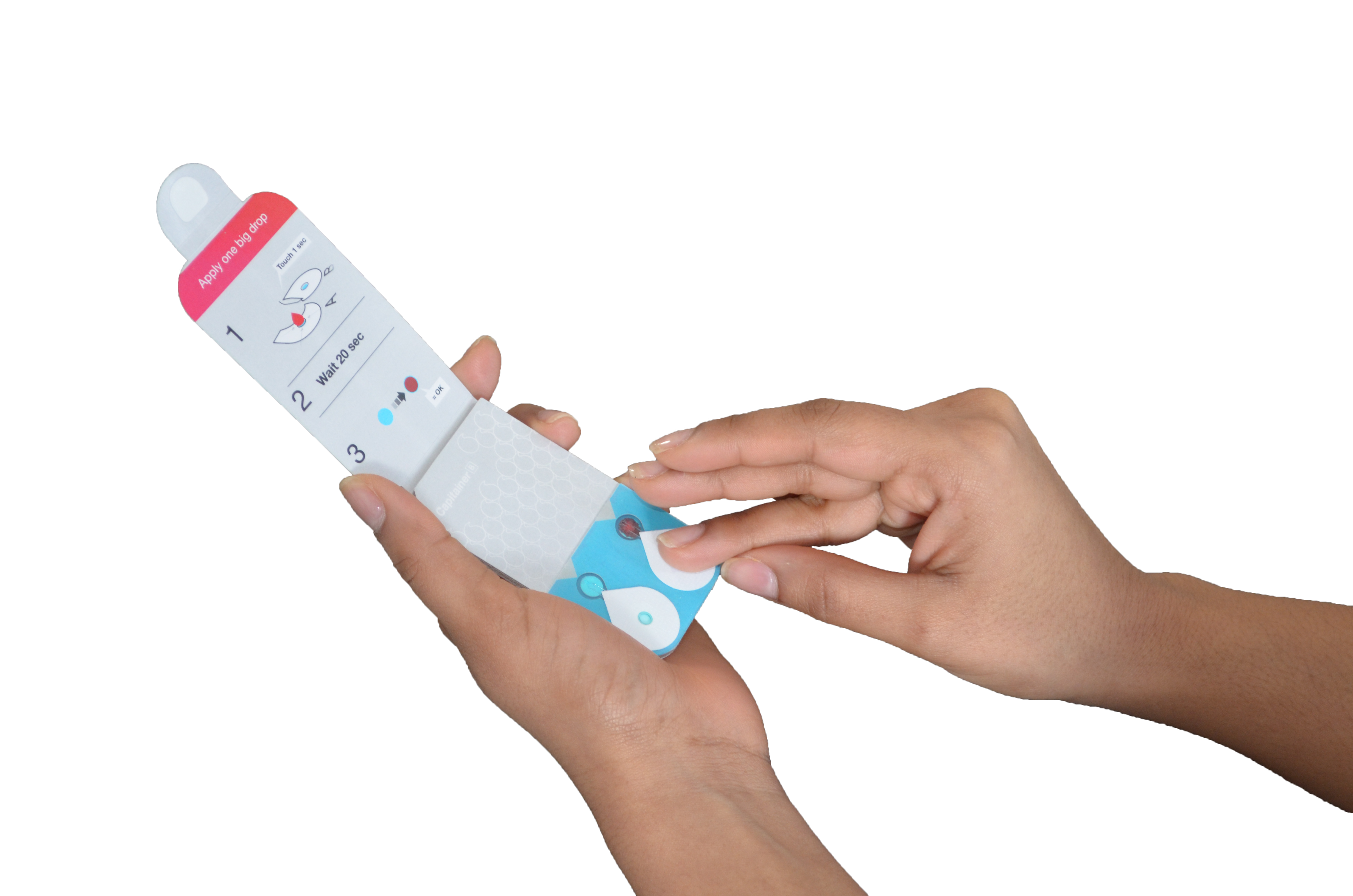Dried blood spot microsampling in screening and monitoring of PKU
Since the 1960s, the use of dried blood spot (DBS) technology for newborn screening (NBS) and monitoring of patients with inherited metabolic disorders (IMDs) has become routine in most parts of the world.
NBS is typically carried out during the first hours or days of a newborn’s life using a few drops of blood collected from the heel – the so-called heel prick test – and/or a urine sample. These samples are then subjected to various testing methods to detect analytes known to be implicated in genetic disorders.
The exact sampling and testing methods for NBS vary around the world, but the ultimate goal is to detect inherited disorders as early in life as possible, so that efforts can be put in place to reduce or manage symptoms, or even prevent them from occurring.
Phenylketonuria – the prototype disorder for newborn screening
Phenylketonuria (PKU) is a rare but potentially fatal metabolic disorder that is characterized by a deficiency or complete absence of the phenylalanine hydroxylase (PAH) enzyme. PAH is responsible for processing the amino acid phenylalanine into tyrosine, and without sufficient PAH activity, phenylalanine accumulates and becomes toxic to the brain.
PKU is inherited in an autosomal recessive pattern and is incurable, but it can be treated by a strict diet designed to keep plasma phenylalanine levels at physiologically safe levels.
Restrictive diets to reduce phenylalanine must be monitored professionally given the critical role of healthy levels of phenylalanine (very low phenylalanine levels are also dangerous), and treatment must be initiated as early as possible after birth to avoid the onset of severe intellectual disability and other symptoms.
Because early dietary treatment has led to greatly improved outcomes for people living with PKU, screening and detection in the first few days after birth has become routine in virtually all countries in which PKU is prevalent.
DBS testing for early detection of PKU and other disorders
In the 1960s, PKU became the prototype disorder for what is now known as DBS technology. This came about as a result of microbiologist Robert Guthrie’s efforts to develop new testing methods for several metabolic disorders, which included the collection of whole blood spots on specially designed filter papers that are commonly referred to as ‘Guthrie cards’.
Guthrie envisioned DBSs as a sample format that could be easily collected, transported and tested, and today, Guthrie cards are widely used in the neonatal heel prick test to detect a number of rare genetic diseases (the exact number depends on country), including PKU and several other inherited metabolic diseases, sickle cell disease, cystic fibrosis, congenital hypothyroidism, and severe combined immunodeficiency (SCID).
A comprehensive list of the analytes measured in DBS samples for IMD monitoring can be found in a recent literature review [1].
DBS is an excellent and obvious choice for PKU monitoring
In DBS testing, finger- or heel prick blood samples are spotted onto and dried on filter paper in a simple and easy manner that offers many advantages over venous blood sampling to screen for PKU, and indeed any of the other genetic disorders that are included in NBS schedules around the world.
Each year in the USA alone, about four million babies are screened shortly after birth for at least 31 serious genetic disorders including PKU. From these NBS programmes, the reported incidence of PKU ranges from one in 13 500 to 19 000 newborns in the USA [Source: www.rarediseases.org]. Babies diagnosed with PKU are monitored throughout their entire lives, increasingly via DBS testing, to ensure optimal dietary control of phenylalanine.
DBS microsampling for PKU monitoring is convenient because it negates the need for a trained phlebotomist to collect blood, allowing the procedure to be carried out remotely, at home, thereby removing any distance or mobility barrier that may prevent one from being tested in a timely manner.
DBS samples are not considered hazardous in any way, allowing them to be sent by regular mail, which is both convenient and cost-effective, especially for the high-volume testing that regular monitoring of diagnosed individuals demands, including monitoring of pregnant women with PKU.
The non-invasive nature of DBS microsampling also makes this approach much more child-friendly because it is less traumatic than a standard blood test, especially given the need for repeat testing.
Finally, although detailed studies on the cost-effectiveness of monitoring IMD patients using at-home DBS samples versus conventional venous blood draws are lacking, a therapeutic drug monitoring study from The Netherlands in 2016 found that switching to DBS home sampling was associated with a total cost reduction (per blood draw) of 43% for blood cancer patients and 61% for nephrology patients [2]. The authors note that total savings depend on the number of hospital visits that can be avoided by using home sampling instead of conventional sampling, suggesting that remote DBS sampling for PKU monitoring in diagnosed individuals may also have some cost advantages.
Advances in sampling and testing allow rapid and accurate screening today
From the 1960s until the 1990s, PKU testing was primarily performed via a PKU inhibition bacterial assay developed by Guthrie.
Here, a gel that supported bacterial growth was coated with β-2-Thienylalanine, which is an analogue of phenylalanine that inhibits the growth of the bacteria Bacillus subtilis. A Guthrie card, containing DBS from an infant heel prick, was then placed on to the gel. Guthrie discovered that phenylalanine reversed the inhibitory effects of β-2-Thienylalanine, so that if the tested blood contained phenylalanine, B. subtilis grew around the blood spot, indicating that the patient had PKU.
Prior to Guthrie’s test, doctors were dependent on a much less reliable test based on the detection of a phenylalanine derivative in the urine, which was taken to indicate that the tested individual could not metabolize phenylalanine.
The emergence of flow injection analysis tandem mass spectrometry (FIA-MS/MS) in the 1990s was a significant step forward in screening for IMDs because it now became possible to accurately detect numerous IMDs in a single assay, making high-throughout testing feasible and allowing an expansion in the number of diseases that could be included in NBS schedules.
Rapid detection of PKU by DBS followed by MS permits prompt changes to treatment in, for example, pregnant women with PKU, and allows fast initiation of dietary treatment in newly diagnosed individuals. Further advances in chromatography and MS (UPLC-MS/MS) since the inception of FIA-MS/MS have greatly improved the specificity and sensitivity of the MS approach, such that it is now possible to accurately detect very low concentra-tions (pmol/L) of disease-associated analytes in high-throughput assays to monitor IMD patients.
Important considerations for DBS testing
Despite the many obvious advantages of DBS for IMD screening and monitoring, a number of factors should be considered to ensure that the final test result is accurate and reproducible, for instance, the need for a fixed accurate sampling volume for quantitative analyte analysis.
Conventional DBS sampling with sub-punches from filter papers results in inconsistent blood volumes and other issues such as the hematocrit (Hct) effect – whereby the proportion of red blood cells (erythrocytes) in the blood influences blood viscosity – all of which impact the reliability of analyte measurements. With new DBS solutions metering an exact volume of blood, as the Capitainer qDBS technology, the Hct effect on sample volume in sub-punches is eliminated (Fig. 1).
The variables to be considered in DBS sampling can be grouped into pre-analytical (sample collection and stability), analytical (sample preparation and properties, confounding factors (e.g. Hct effect), assay standards and controls) and post-analytical factors (translatability of results to plasma analyte concentrations and comparison to target analyse treatment ranges). These factors are covered extensively elsewhere and will not be discussed further here [1].
Summary
In summary, DBS for PKU screening and monitoring has greatly changed the outcome for patients living with this disease since the 1960s. Continuous advances in quantitative DBS sampling and rapid, sensitive, and specific analyte detection methods provide a great opportunity for high-throughput screening and monitoring of many analytes in the future, where convenient sampling, sample transportation, accurate detection, and cost-effectiveness stand to greatly improve the outcomes for individuals living with IMDs and other genetic disorders.
Figure 1. Quantitative dried blood spot technology delivers an exact volume of blood, and so the hematocrit effect on sample volume in sub-punches is eliminated (Source: Capitainer)
The authors
Karen O’Hanlon Cohrt PhD (Science Writer) and
Mikael Ström PhD (Business Development Manager, Capitainer) Capitainer AB, SE-171 45 Solna, Sweden
E-mail: info@capitainer.se
References
- Moat SJ, George RS, Carling RS. Use of dried blood spot specimens to monitor patients with inherited metabolic disorders. Int J Neonatal Screen 2020;6(2):26 (https://doi.org/10.3390/ijns6020026).
- Martial LC, Aarnoutse RE, Schreuder MF et al. Cost evaluation of dried blood spot home sampling as compared to conventional sampling for therapeutic drug monitoring in children. PLoS One 2016;11:e0167433 (https://doi.org/10.1371/journal.pone.0167433).
Acknowledgement
This is an original blog post from Capitainer, published with permission. For more information visit https://capitainer.se/.
Capitainer raises additional SEK34 million to meet the increasing demand for home-sampling solutions
The Swedish medtech start-up company has announced that it has closed a share issue of SEK34 million to capitalise on growing interest in home-sampling with its new qDBS dried blood spot testing system. The investment round, led by Sciety, brought in both existing and new industry specialist investors and several board members and the CEO.
Ernst Westman, Capitainer Chairman, commented: “Once again we are delighted to have secured such strong support from experienced medtech and diagnostics industry investors. COVID-19 presented us with an unexpected obstacle, but also a welcomed opportunity to prove the utility of our products. This success has generated unprecedented interest worldwide and the new funding will enable us to accelerate both our product development and commercialization efforts.”
Christopher Aulin, CEO, added: “Our home-sampling products have generated interest across the whole spectrum of diagnostic testing. From drugs of abuse to metabolic disorders, we are being contacted by leading specialists in Europe and the US interested in exploring different applications for qDBS. However, this is only half the story, as we will also use this new funding to accelerate our product development to broaden our product platform to include plasma and urine sample collection.”
Capitainer has now firmly established that the home-sampling system works for clinical use, with an impressive success rate with first time users. Patients can use Capitainer’s qDBS system to collect their own blood sample for diagnostic testing as a dried blood spot in the privacy of their home. The patented technology ensures exact sample volumes of 10µl with low CV, independent of hematocrit. Patients simply apply one drop of capillary blood from a finger prick to the inlet port on the qDBS card which automatically fills a microchannel with the required amount and discards any excess. The potential for human error is thus significantly reduced. Subsequently, the blood volume contained in the microchannel automatically transfers to the specimen collection disc, forming a high-quality dried blood spot sample, preserved for quantitative bioanalysis. The filled card can then be safely transported to the point of testing without the need for refrigeration or specialized packaging.
For more information visit www.capitainer.se.






